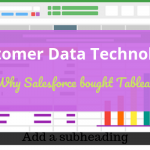
Comparing Marketing Channels for Demand Gen
Time to read: 4 Minutes
During our June 2017 DC MarTech Talk, we dove into talking about lead sources that work, that leads to sales. Taking the B2B angle, we had Sean McVey, Director Demand Gen at Virtru. His company, is a B2B SaaS where marketing hopes to drive inbound traffic to the free trial period, so customers can try the service. Here, we dive into comparing marketing channel for demand gen for early-stage companies.
Once again, the evaluation framework includes the standard set of marketing metrics:
- Cost: total and average
- Conversion Funnel: Marketing qualified leads (MQLs) , sales accepted leads (SALs), sales qualified leads (SQLs), and wins
- Average Sale Price (ASP) = Total Revenue/Wins
- Return on Investment (ROI) = Revenue/Cost
- Customer Lifetime Value = Revenue * average lifetime value of a contract
- Length of Sales Cycle: in months
Seven Ways to Invest: Comparing Marketing Channels for Demand Gen
A mix of activities across several channels drives inbound demand generation and sales for B2B. Specifically, they are – and we talked about – the following seven channels:
- Organic Search
- Paid Search
- Paid Social
- Events & Webinars
- Partners/Resellers
- Third Party Lead Gen
- Third Party List Providers
And the results are probably expected.
There was return on investment for search, third party list providers, and of course, partners and resellers. ROI for events and webinars is a mixed bag, heavily depending on choosing the right ones. The marketing money losers are paid social and third party lead gen.
Before we get into that, let’s first talk about the details of positive ROI activities.
Positive ROI for Search and Third Party List Vendors
Search is cheap. Organic search is simply great content and so that is the least expensive route. Regardless of whether search was organic or paid, it had a high conversion rates, low average sales prices, short sales cycles and are best for new leads.
List providers – to power your outbound demand gen – are generally not terribly costly and have a positive ROI. Costs vary highly according to the source, but that cost of the data source tends to correspond with data quality. Important to remember.
Like most things in life, with list providers, you get what you pay for. Spring for higher quality data because while sales cycle is long, the reward is higher conversion rates as well. In addition, higher quality lists mean a high average sales price as well.
Mixed ROI for Webinars and Events
Events and webinar have a mixed ROI – pretty much for everyone. Webinars are much lower costs. They also have high conversion rates at the top of the funnel and low rates at the bottom. If you’re doing great targeting, they tend to have higher than average sales price. Of course, with high average sales price, it also means longer sales cycles.
Finally, webinars accelerate your pipeline and do a great job of disqualifying leads fast. Although, this assumes you define webinar topics to do just that.
Live events have a mixed ROI. Some events are great, others are big money losers and there tends to be nothing in between. Live events generally follow the same trends as webinars. Conversion rates are mixed, but average sales prices trend higher and with that, longer sales cycle.
The Dogs: Paid Social and Third Party Lead Gen Firms
So, now let’s talk about comparing marketing channels for demand gen that is not as effective on the bottom line. Paid social. Third party lead gen firms.
Why doesn’t paid social and outsourced lead generation work?
Hard to Measure Impact on Paid Social
It’s hard to say that it does not work when paid social seems tough to measure in the first place. It’s simply hard see its impact on wins and actual sales.
If you can’t directly relate it to the outcome, it’s impossible to say anything about sales cycles or return on investment. But, paid social is not really expensive. Also, it’s best to use it for ad re-targeting and to build awareness and branding.
Expensive Lead Gen Firms Makes ROI Difficult
Lead gen firms are very expensive, so ROI is automatically tougher to achieve.
However, no one generally outsources lead gen to go after small companies. Spend that money to penetrate fast-growing companies or enterprise accounts for the larger deals; and with those kind of accounts come higher average sales prices and longer sales cycles.
While third party lead gen was a budget waster for this B2B SaaS company, don’t wholesale write off this approach. For example, say you have a small, niche market of a very large deal sizes. In this case, using the RIGHT third party lead gen firm could be a smart way to fill your pipeline.
First, Go Inbound
In sum, comparing marketing channels for demand for this B2B SaaS company turned up yet another solid argument for inbound. However, that has a lot to do with their growth stage. We’ll check back in 2 years, after it outgrows its startup phase and growth starts to slow. More mature companies have both bigger teams and bigger budgets and most certainly use different marketing channels.








